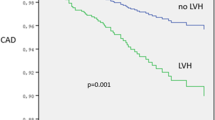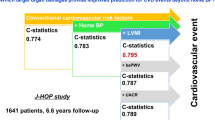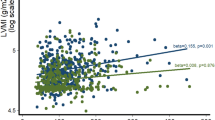Abstract
We investigated whether inappropriately high left ventricular (LV) mass, defined as observed LV mass exceeding the level of individual LV mass predicted from gender, height, and stroke work, may be associated with an imbalance between growth-promoting and growth-inhibitory factors and/or structural vascular changes. In 53 patients with hypertension and electrocardiographic LV hypertrophy, 24-h ambulatory blood pressure (BP); echocardiographic LV mass, stroke volume and stroke work; minimal forearm vascular resistance (MFVR); and intima–media cross-sectional area in common carotid arteries (IMA) were evaluated after 2 weeks of placebo treatment. Serum insulin, plasma epinephrine, norepinephrine, endothelin, angiotensin II, aldosterone, and brain natriuretic peptide (BNP) were also measured. High observed LV mass was related to high IMA (r=0.46, P<0.001), MFVR (in men: r=0.36, P<0.05), 24-h ambulatory systolic BP (r=0.30, P=0.06), and lower plasma angiotensin II (r=−0.33, P<0.05), but not to other circulating growth factors. Stroke work was similarly related to IMA (r=0.42, P<0.01), MFVR (in men: r=0.41, P<0.05), and plasma angiotensin II (r=−0.32, P<0.05). Inappropriate LV mass, identified by the ratio between observed LV mass and the value predicted for gender, height, and stroke work, was not significantly related to any of the arterial or neurohormonal variables. In this small series of older hypertensive patients, inappropriate LV mass was not significantly related to arterial changes or to measured circulating growth factors, although weak relations cannot be excluded. Alternatively, inappropriately high LV mass might be related to unmeasured factors such as local myocardial alterations in growth factors and/or genetic predisposition to develop excessive LV hypertrophy.
This is a preview of subscription content, access via your institution
Access options
Subscribe to this journal
Receive 12 digital issues and online access to articles
$119.00 per year
only $9.92 per issue
Buy this article
- Purchase on Springer Link
- Instant access to full article PDF
Prices may be subject to local taxes which are calculated during checkout
Similar content being viewed by others
References
de Simone G et al. Interaction between body size and cardiac workload: influence on left ventricular mass during body growth and adulthood. Hypertension 1998; 31: 1077–1082.
Celentano A et al. Inappropriate left ventricular mass in normotensive and hypertensive patients. Am J Cardiol 2001; 87: 361–363.
Olsen MH et al. Is cardiovascular remodeling in patients with essential hypertension related to more than high blood pressure? A LIFE substudy. Losartan Intervention For Endpoint-Reduction in Hypertension. Am Heart J 2002; 144: 530–537.
Inoue M et al. Impaired expression of brain natriuretic peptide gene in diabetic rats with myocardial infarction. Exp Clin Endocrinol Diabetes 1998; 106: 484–488.
Chen HH, Burnett JC . Natriuretic peptides in the pathophysiology of congestive heart failure. Curr Cardiol Rep 2000; 2: 198–205.
Ikeda M et al. Natriuretic peptide family as a novel antimigration factor of vascular smooth muscle cells. Arterioscler Thromb Vasc Biol 1997; 17: 731–736.
Yasumoto K et al. Relation of plasma brain and atrial natriuretic peptides to left ventricular geometric patterns in essential hypertension. Am J Hypertens 1999; 12: 921–924.
Olsen MH et al. Relative influence of insulin resistance versus blood pressure on vascular changes in longstanding hypertension. ICARUS, a LIFE sub study. Insulin Carotids US Scandinavia. J Hypertens 2000; 18: 75–81.
Dahlof B et al. Characteristics of 9194 patients with left ventricular hypertrophy: the LIFE study. Losartan Intervention For Endpoint Reduction in Hypertension. Hypertension 1998; 32: 989–997.
Devereux RB et al. Relations of left ventricular mass to demographic and hemodynamic variables in American Indians: the Strong Heart Study. Circulation 1997; 96: 1416–1423.
Schiller NB et al. Recommendations for quantitation of the left ventricle by two-dimensional echocardiography. American Society of Echocardiography Committee on Standards, Subcommittee on Quantitation of Two-Dimensional Echocardiograms. J Am Soc Echocardiogr 1989; 2: 358–367.
Palmieri V et al. Reliability of echocardiographic assessment of left ventricular structure and function: the PRESERVE study. Prospective Randomized Study Evaluating Regression of Ventricular Enlargement. J Am Coll Cardiol 1999; 34: 1625–1632.
Howard G et al. Carotid artery intimal–medial thickness distribution in general populations as evaluated by B-mode ultrasound. ARIC Investigators. Stroke 1993; 24: 1297–1304.
Roman MJ et al. Parallel cardiac and vascular adaptation in hypertension. Circulation 1992; 86: 1909–1918.
Folkow B . Physiological aspects of primary hypertension. Physiol Rev 1982; 62: 347–504.
Utriainen T, Malmstrom R, Makimattila S, Yki-Jarvinen H . Methodological aspects, dose-response characteristics and causes of interindividual variation in insulin stimulation of limb blood flow in normal subjects. Diabetologia 1995; 38: 555–564.
Mulvany MJ, Halpern W . Contractile properties of small arterial resistance vessels in spontaneously hypertensive and normotensive rats. Circ Res 1977; 41: 19–26.
Imai Y et al. The accuracy and performance of the A&D TM 2421, a new ambulatory blood pressure monitoring device based on the cuff-oscillometric method and the Korotkoff sound technique. Am J Hypertens 1992; 5: 719–726.
Conway J, Coats A . Value of ambulatory blood pressure monitoring in clinical pharmacology. J Hypertens Suppl 1989; 7: S29–S32.
Andersen L et al. Enzyme immunoassay for intact human insulin in serum or plasma. Clin Chem 1993; 39: 578–582.
Appel E et al. Determination of plasma catecholamines by means of radioenzymatic labelling and high pressure liquid chromatographic separation. Naunyn Schmiedebergs Arch Pharmacol 1981; 315: 233–239.
Poulsen K, Jorgensen J . An easy radioimmunological microassay of renin activity, concentration and substrate in human and animal plasma and tissues based on angiotensin I trapping by antibody. J Clin Endocrinol Metab 1974; 39: 816–825.
Millar JA et al. A microassay for active and total renin concentration in human plasma based on antibody trapping. Clin Chim Acta 1980; 101: 5–15.
Kappelgaard AM, Nielsen MD, Giese J . Measurement of angiotensin II in human plasma: technical modifications and practical experience. Clin Chim Acta 1976; 67: 299–306.
Shimizu H et al. Stability of brain natriuretic peptide (BNP) in human blood samples. Clin Chim Acta 1999; 285: 169–172.
de Simone G et al. Relation of hemodynamics and risk factors to ventricular–vascular interactions in the elderly: the Cardiovascular Health Study. J Hypertens 2001; 19: 1893–1903.
Brilla CG . The cardiac structure–function relationship and the renin–angiotensin–aldosterone system in hypertension and heart failure. Curr Opin Cardiol 1994; 9 (Suppl 1): S2–S10.
de Simone G, Pasanisi F, Contaldo F . Link of nonhemodynamic factors to hemodynamic determinants of left ventricular hypertrophy. Hypertension 2001; 38: 13–18.
de Simone G et al. In vivo left ventricular anatomy in rats with two-kidney, one clip and one-kidney, one clip renovascular hypertension. J Hypertens 1992; 10: 725–732.
de Simone G et al. Influence of sodium intake on in vivo left ventricular anatomy in experimental renovascular hypertension. Am J Physiol. 1993; 264: H2103–H2110.
Ganau A et al. Relation of left ventricular hemodynamic load and contractile performance to left ventricular mass in hypertension. Circulation 1990; 81: 25–36.
Acknowledgements
We acknowledge technical assistance by Lisa Krause in Ann Arbor, Michigan, USA, in measuring IMT, and Paulette A Lyle for assistance in preparation of the manuscript. This work was supported in part by the Grants from The Danish Medical Association Research Fund, Copenhagen, Denmark; The Becket-Foundation, Copenhagen, Denmark; Editor and Mrs. Anders Christian Kaarsens Foundation, Copenhagen, Denmark; and Merck & Co, Inc, West Point, PA, USA as part of the LIFE ICARUS substudy.
Author information
Authors and Affiliations
Corresponding author
Rights and permissions
About this article
Cite this article
Olsen, M., Wachtell, K., de Simone, G. et al. Is inappropriate left ventricular mass related to neurohormonal factors and/or arterial changes in hypertension? a LIFE substudy. J Hum Hypertens 18, 437–443 (2004). https://doi.org/10.1038/sj.jhh.1001720
Published:
Issue Date:
DOI: https://doi.org/10.1038/sj.jhh.1001720



